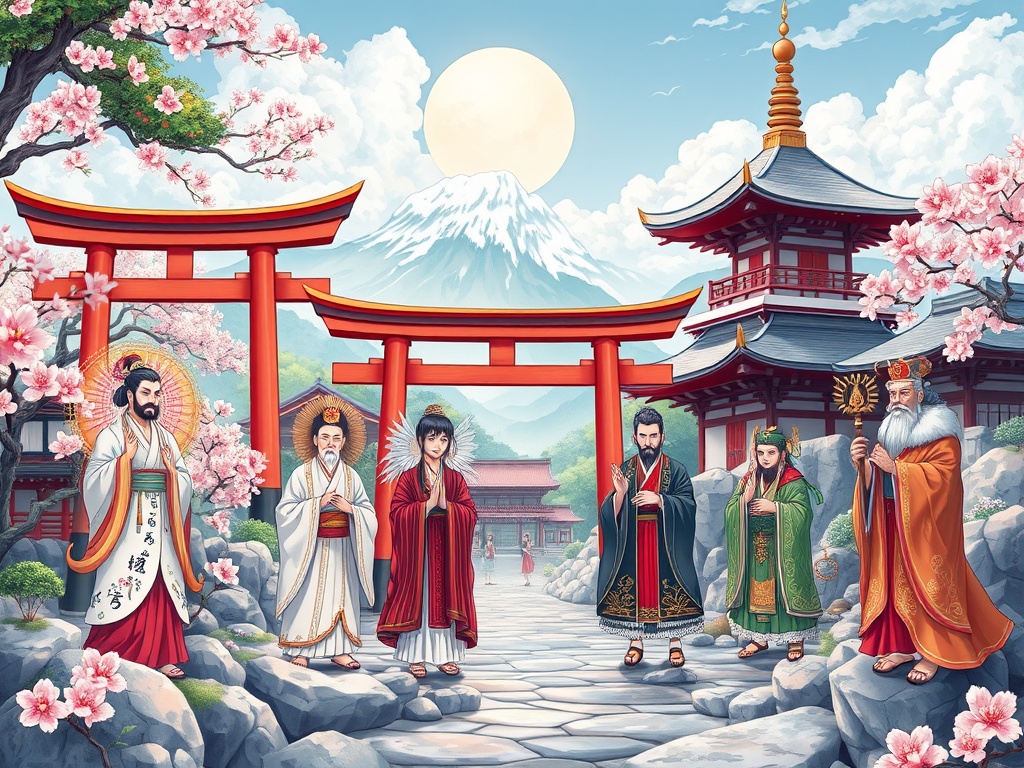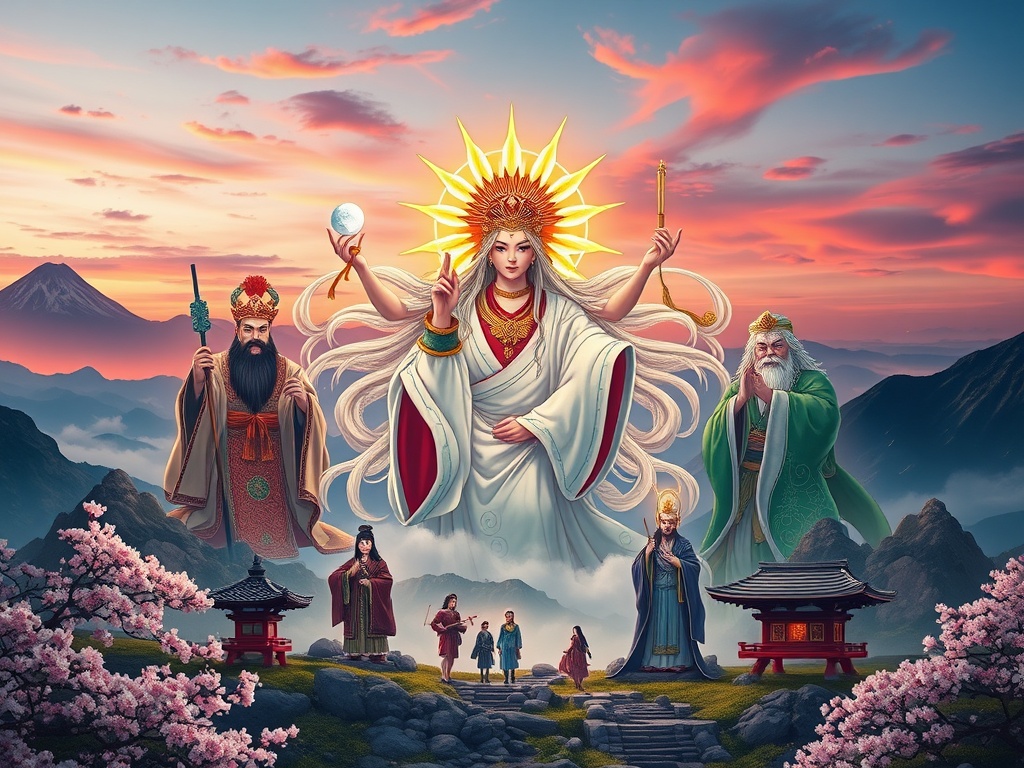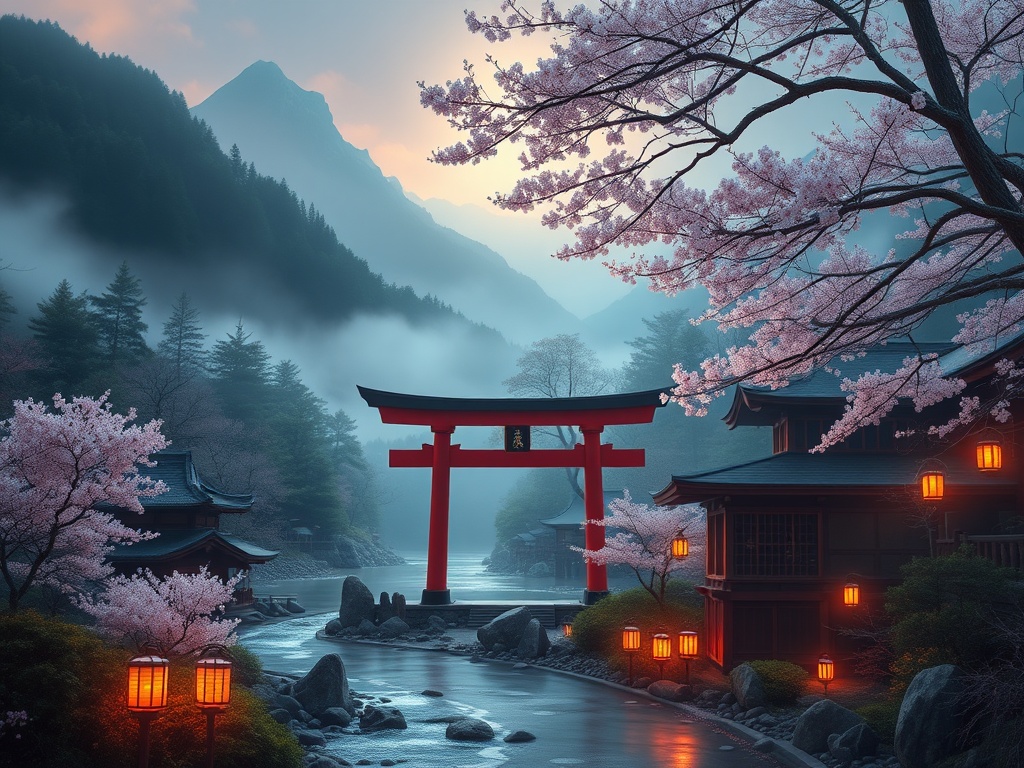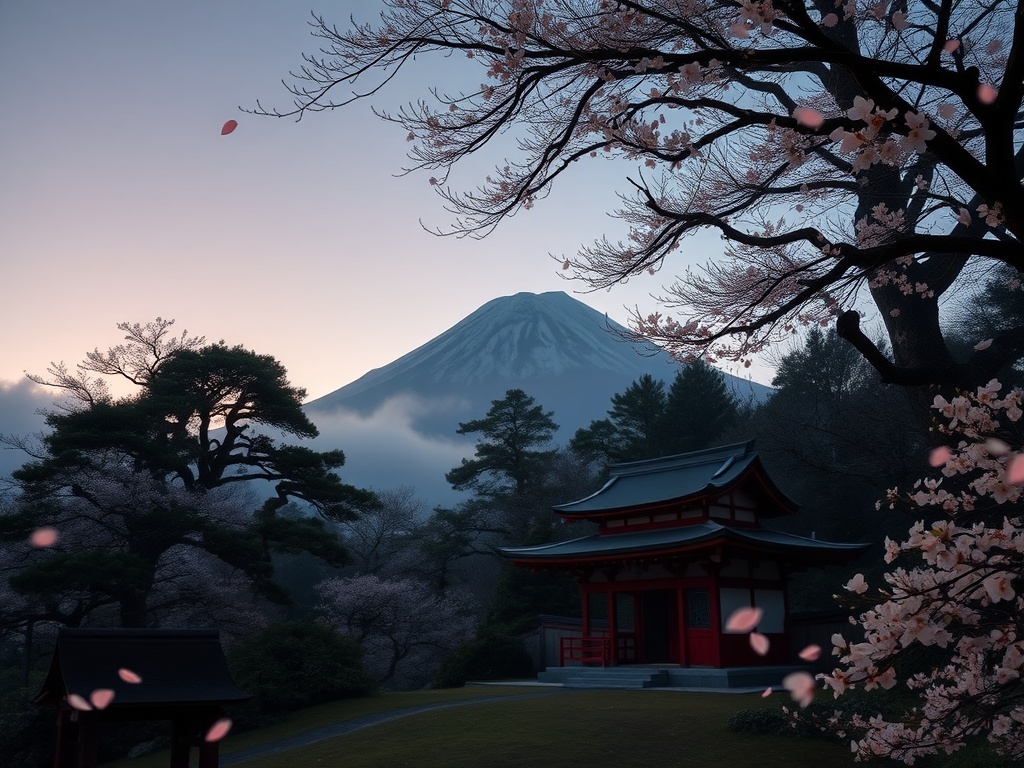Divine Pantheon: Meet the Majestic Deities of Japanese Myth
Win a Free Trip to Japan!
Experience cherry blossoms and ancient temples
Embark on a mystical journey through the realm of Japanese mythology where divine spirits known as kami reign supreme. These celestial beings are revered throughout Japan, each representing a unique aspect of life and nature. Whether you’re exploring the verdant landscapes of Kyoto or the bustling streets of Tokyo, the presence of these deities is omnipresent, offering a spiritual glimpse into Japan’s rich cultural tapestry.
Shinto, the indigenous faith of Japan, is home to a plethora of kami—deities that embody the spiritual essence of nature. From the majestic mountains to the gentle rivers, each element of the natural world is believed to be the dwelling place of these revered spirits. Let’s delve into the realm of the Shinto kami and meet some of the most prominent deities worshipped in Japan.
- Amaterasu: The sun goddess and the most venerated kami, Amaterasu is believed to be the ancestress of the Imperial Family of Japan. Her divine light illuminates the path for her followers.
- Susanoo: Known as the storm god, Susanoo is both feared and respected. His tempestuous nature is a reminder of the unpredictable power of the seas and storms.
- Inari: The deity of rice and agriculture, Inari is often depicted with foxes, which serve as its messengers. This kami is celebrated for bringing prosperity and abundance.
Beyond the Shinto deities, Japanese mythology is enriched by the influence of Buddhism, which introduced a pantheon of its own spiritual entities. These enigmatic spirits offer a fascinating blend of Indian, Chinese, and native Japanese beliefs, creating a unique spiritual landscape.
The introduction of Buddhism to Japan brought with it a new array of deities and bodhisattvas, enriching the spiritual and cultural diversity of the nation. These figures often embody compassion, wisdom, and protection, and they have seamlessly integrated into the fabric of Japanese religious life.
- Jizo: Known as the protector of travelers and children, Jizo is one of the most beloved figures in Japanese Buddhism. Statues of Jizo can be found across the country, often adorned with offerings and red bibs.
- Kannon: The bodhisattva of compassion, Kannon is revered for its ability to alleviate suffering. Temples dedicated to Kannon, such as the famous Senso-ji in Tokyo, are popular pilgrimage sites.
Mythical Landscapes: Exploring the Sacred Sites of Japan’s Gods
Japan is a land where the divine and the earthly coexist in harmony, with its landscapes dotted by sacred sites that honor the myriad of gods and spirits in its rich mythology. From the ancient shrines nestled in dense forests to the majestic temples perched on mountainsides, these holy places offer not just a spiritual experience, but also a journey through the deep cultural and historical roots of the nation. As you traverse these mystical landscapes, you will find yourself enveloped in the aura of the divine, each location telling its own story of the gods who once walked the earth.
Japan’s mountainous terrain is revered as the abode of kami, and many peaks are considered sacred, drawing pilgrims and travelers alike. Mount Fuji, perhaps the most iconic of these, is not only a symbol of Japan but also a sacred site where ancient rituals are still performed. Pilgrims ascend its slopes to reach the summit, seeking spiritual renewal and a closer connection to the kami believed to reside there. Similarly, the Kii Mountain Range hosts the Kumano Kodo, a network of pilgrimage routes that traverse lush forests and lead to grand shrines, offering a journey through both nature and spirituality.
Off the coast of Japan, the islands themselves hold mythical significance, often seen as floating realms of the gods. The island of Miyajima, home to the Itsukushima Shrine, is famously known for its ‘floating’ torii gate, which appears to hover above the sea during high tide. This island is a testament to the seamless integration of natural beauty and spiritual reverence, drawing visitors into its serene embrace. Further south, Okinoshima is an island shrouded in mystery, designated a World Heritage site for its untouched nature and sacred status. It serves as a place of worship, where rituals have been performed for centuries, maintaining a deep connection to the divine.
Tales of the Kami: Legends That Shaped Japan’s Spiritual Heritage
Dive into the captivating lore of Japan’s spiritual heritage, where the tales of the kami illuminate the cultural landscape with stories of creation, struggle, and harmony. Each legend offers a window into the beliefs and values that have been cherished by generations, painting a rich tapestry of the divine narrative that influences modern life and spiritual practices in Japan. As you journey through these tales, you’ll uncover the profound connections between the land, its people, and the celestial beings that guide them.
Among the most enthralling stories in Japanese mythology are the creation myths, which narrate the birth of the islands and the gods themselves. Central to these tales is the story of Izanagi and Izanami, the divine couple tasked with bringing form to the world. With their spear of creation, they stirred the oceans, giving rise to the Japanese archipelago. Their union produced many other deities, including Amaterasu, the sun goddess, and Susanoo, the storm god, whose exploits and rivalries are emblematic of the natural forces at play in the world.
These creation myths are not just stories of origin but are deeply embedded in the cultural consciousness, influencing everything from court rituals to everyday practices. They provide a framework for understanding the divine hierarchy and the interconnectedness of all existence.
In addition to creation myths, Japanese legends are replete with tales of heroic deeds and moral lessons, often conveyed through the actions of courageous kami and legendary figures. The story of Susanoo’s battle with the fearsome serpent Yamata no Orochi is a classic example, highlighting themes of bravery, wit, and redemption. This tale not only captivates with its dramatic narrative but also imparts values of resilience and justice.
Such stories have been passed down through generations, often through oral tradition, plays, and festivals, ensuring that the virtues they espouse remain a guiding light for the society. As you explore these narratives, you’ll find that they offer profound insights into the ethical and philosophical underpinnings of Japanese culture.
Cultural Encounters: Festivals Celebrating Japan’s Celestial Beings
Japan’s vibrant cultural tapestry is intricately woven with celebrations that honor the divine kami and celestial beings of its mythology. These festivals are more than mere spectacles; they are a living testament to the nation’s spiritual heritage, inviting both locals and travelers to partake in rituals that have been cherished for centuries. As you immerse yourself in these festivities, you will encounter a rich blend of tradition, spirituality, and communal joy, offering a unique glimpse into the heart of Japanese culture.
The heart of Japanese cultural celebrations lies in the Matsuri, or festivals, that take place across the country. These events are a vibrant display of gratitude and reverence towards the kami, each festival uniquely tailored to honor specific deities. In the springtime, the Hanami festivals celebrate the fleeting beauty of cherry blossoms, symbolizing the delicate and ephemeral nature of life. During these gatherings, revelers enjoy picnics under blooming sakura trees, sharing food and drink while partaking in traditional music and dance.
In contrast, the summer sees the grand celebration of the Gion Matsuri in Kyoto, one of Japan’s most famous and historic festivals. This month-long event features elaborate processions of beautifully decorated floats, known as yamaboko, parading through the streets, each float representing a different kami or legendary figure. The Gion Matsuri is a spectacle of color and pageantry, drawing visitors from around the world to witness its grandeur and partake in the festive spirit.
Throughout the year, Japan’s festivals also mark significant transitions and cycles, aligning with both the agricultural calendar and spiritual beliefs. The Aki Matsuri, or Autumn Festival, is a time for giving thanks for the harvest and seeking blessings for the coming year. These celebrations often include rituals of purification and renewal, where participants engage in ceremonies to cleanse themselves and their surroundings, inviting prosperity and peace.
Another notable festival is the Obon, a Buddhist event that honors ancestral spirits. During Obon, families gather to clean graves, light lanterns, and perform traditional dances called Bon Odori. It is a time of reflection and remembrance, as well as a celebration of the enduring connection between the living and the departed, underscoring the cyclical nature of life and the spiritual world.
Heavenly Guardians: Discover the Protector Gods of Japan’s Regions
Embark on a fascinating exploration of Japan’s diverse regions, where each area is safeguarded by its own unique protector gods. These heavenly guardians form a celestial network of protection and prosperity, revered by local communities for their watchful presence and divine intervention. As you travel through Japan, stepping into the sacred precincts where these deities are honored, you’ll witness firsthand the deep-rooted spiritual connections that bind the land and its people to their divine protectors.
Japan’s landscape is dotted with shrines dedicated to regional deities, each one a testament to the spiritual heritage and cultural identity of its locale. These protector gods are often associated with specific natural features or historical events, embodying the essence of the region they watch over. Their stories and attributes vary widely, reflecting the rich tapestry of myths that span the archipelago.
Here’s a glimpse at some notable regional protector gods:
- Amenominakanushi: Known as the ‘Master of the Heavenly Center,’ this kami is considered one of the primordial deities, overseeing the creation and harmony of the universe. Revered in the Kanto region, shrines dedicated to Amenominakanushi offer a serene retreat for reflection and meditation.
- Okuninushi: Widely worshipped in the San’in region, Okuninushi is heralded as a god of nation-building and medicine. His presence is especially felt at the Izumo Taisha, one of Japan’s oldest and most significant shrines, where he is honored as a benevolent protector of health and prosperity.
- Hachiman: As the divine protector of warriors and the Minamoto clan, Hachiman is venerated throughout Kyushu. His shrines, notably the Usa Jingu, serve as spiritual fortresses, offering blessings for courage and success in endeavors.
Throughout the year, regional festivals and rituals celebrate these guardian deities, showcasing the vibrant cultural traditions and community spirit that define Japanese society. These events are not only religious observances but also lively gatherings that unite locals and visitors in communal joy.
The following list highlights a few of these captivating celebrations:
- Hakata Gion Yamakasa: Held in Fukuoka, this energetic festival features teams racing massive floats through the city streets, honoring the protective spirit of Kushida Shrine.
- Nagasaki Kunchi: A colorful event celebrating Suwa Shrine’s guardian deities, featuring dragon dances and traditional performances that captivate audiences with their dynamic displays.
- Izumo Taisha Grand Festival: An annual pilgrimage attracting thousands who seek Okuninushi’s blessings, marked by solemn ceremonies and joyful processions within the historic shrine grounds.
Journey Through Time: The Evolution of Japan’s Mythological Icons
As you embark on a fascinating journey through time, you’ll discover how the mythological icons of Japan have evolved, reflecting the nation’s dynamic cultural and historical landscape. From ancient times to the present day, these deities have not only shaped the spiritual beliefs of the Japanese people but have also influenced art, literature, and societal norms. This evolution is a testament to the enduring legacy and adaptability of Japan’s mythological heritage.
In the earliest days of Japan’s history, mythology served as a foundation for understanding the natural world and establishing societal order. The initial pantheon of gods, born from the tales of Izanagi and Izanami, laid the groundwork for a deeply spiritual culture. Over centuries, these myths were transmitted through oral traditions, evolving as they were woven into the fabric of everyday life. The introduction of Chinese characters allowed for the documentation of these legends, leading to the compilation of the ‘Kojiki’ and ‘Nihon Shoki’, Japan’s oldest chronicles, which preserve the stories of the kami in written form.
The arrival of Buddhism in the 6th century marked a significant turning point in the evolution of Japanese mythology. As Buddhism spread across the archipelago, its deities and narratives began to intertwine with the existing Shinto beliefs. This integration led to the creation of a unique spiritual landscape, where Buddhist and Shinto deities coexisted and complemented each other. Icons such as Kannon, the bodhisattva of compassion, became seamlessly integrated into the cultural and religious life of Japan, offering new dimensions to the traditional pantheon.
In today’s Japan, the legacy of mythological icons continues to influence contemporary culture in unexpected ways. Through popular media, such as anime, manga, and film, these ancient deities are reimagined and revived, capturing the imagination of new generations. Festivals and rituals dedicated to these gods offer a vibrant connection to the past, inviting both locals and visitors to experience the timeless allure of Japan’s mythological heritage. This enduring presence highlights the adaptability and resilience of these stories, ensuring that they remain a cherished part of Japan’s cultural identity.
Gods and Nature: Understanding the Elemental Spirits of Japan
Embark on a captivating journey through the enchanting world of Japanese mythology, where the elemental spirits known as kami are revered as the divine embodiment of nature’s power and beauty. These celestial beings are deeply intertwined with the natural world, embodying the essence of the earth, water, fire, and air. As you explore the sacred landscapes of Japan, you’ll discover how these elemental spirits are celebrated and honored, offering a profound insight into the cultural reverence for nature.
The lush landscapes of Japan are home to a myriad of kami associated with earth and water, essential elements that sustain life. The earth kami, or chi-no-kami, are venerated for their role in fertility and stability. Mountains, forests, and fields are seen as their sacred abodes, where rituals and offerings are made to ensure bountiful harvests and prosperity. Among these, Oyamatsumi stands out as a prominent deity of mountains, revered for his protection and nurturing presence.
Water, too, holds a sacred place in Japanese belief. The kami of rivers and seas, known as sui-no-kami, are celebrated for their life-giving and purifying qualities. Sarutahiko, the bridge between heaven and earth, is often invoked for safe travel across water, while the dragon god Ryujin governs the oceans, symbolizing the mysterious depths and immense power of the sea.
The dynamic forces of fire and air are equally integral to the Japanese spiritual landscape. Fire kami, or hi-no-kami, are associated with transformation and purification. Amaterasu, the sun goddess, embodies the life-giving warmth and light of the sun, bringing vitality and growth. Her presence is celebrated through festivals that invite the community to bask in her radiant blessing.
Meanwhile, the air kami, known as fu-no-kami, govern the winds and skies, guiding travelers and influencing weather patterns. Fujin, the wind god, is depicted with a bag of winds, releasing gusts that shape the seasons, while Shinatsuhiko ensures the gentle breezes that bring calm and serenity.
These elemental spirits not only highlight the interconnectedness of the natural world but also serve as a reminder of the harmony that exists between humans and the environment. By understanding and respecting these kami, travelers can gain a deeper appreciation for Japan’s rich cultural heritage and the timeless wisdom it offers.
From Myth to Reality: Tracing the Influence of Gods in Modern Japan
The rich tapestry of Japanese mythology is not just a relic of the past; it continues to weave through the fabric of modern Japan, influencing cultural practices, artistic expressions, and everyday life. For those traveling through the Land of the Rising Sun, understanding this profound connection offers a unique lens through which to appreciate the country’s vibrant culture and traditions. From bustling urban centers to serene rural landscapes, the legacy of the kami is omnipresent, inviting visitors to explore the deeper meanings behind Japan’s contemporary allure.
In modern Japan, the influence of traditional deities manifests in a myriad of ways, blending seamlessly with contemporary life. Shinto and Buddhist practices continue to be an integral part of social and cultural events, with rituals and ceremonies marking significant life transitions such as births, weddings, and New Year celebrations. Temples and shrines, nestled amidst urban skyscrapers or perched atop scenic hills, remain vibrant centers of community life, where locals and tourists alike can experience the timeless rituals that honor these ancient gods.
The annual festivals, known as Matsuri, are another testament to the enduring presence of these deities. Celebrated with colorful parades, traditional music, and dance, these events are not only a homage to the kami but also a celebration of community spirit and cultural heritage. Whether participating in the energetic Gion Matsuri of Kyoto or witnessing the tranquil beauty of the cherry blossom festivals, travelers are offered a glimpse into the spiritual heart of Japan.
Beyond religious and cultural practices, the gods of Japanese mythology have found new life in the realm of pop culture, capturing the imagination of audiences worldwide. Anime, manga, and video games often draw upon these ancient stories, reimagining them in ways that resonate with today’s audiences. Characters inspired by gods like Amaterasu and Susanoo become heroes of fantastical tales, bringing the myths to life on screens and pages, while also introducing them to a global audience.
This intersection of mythology and modernity can be seen in popular destinations such as Akihabara in Tokyo, where fans of Japanese pop culture can immerse themselves in the vibrant world of anime and gaming. As visitors explore these dynamic spaces, they are participating in the ongoing evolution of Japan’s mythological narrative, where ancient deities continue to inspire and entertain.



